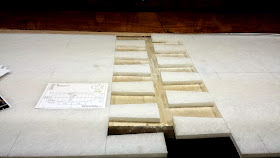There seems to be some debate as to what genus that the larger Gray or Slate colored mayflies we come across on the Lower Yuba really are. The concensus is that they are Drakes. Are they the genus
Siphlonurus or are they the genus
Isonychia? I'm not an entomologist so the best I can do is research.
According to the information in the book "Flyfishers Guide to Northern California" put together by Seth Norman, the chapter authored by our local Ralph Wood, states that they are Gray Drakes or
Siphlonurus occidentalis.
Hogan Brown has remarked that there is a minor
Isonychia hatch on the Lower Yuba of which he has created a pattern the "Isonychia Nymph" to match.
Dave Sloan who regularly guides on the Lower Yuba has also come up with a fly to match the Isonychia mayfly, Sloan's Bead Head Mighty May Hendrickson fly pattern He states that it is an extremely effective choice when imitating mature Hendrickson (or Isonychia) nymphs.
The
Siphloeurus mayfly is commonly referred to as the "
Gray Drake". The
Isonychia mayflies are commonly referred to as the "
Slate Drake".
When I looked up the Slate Drake or
Isonychia mayfly on the "Trout Nut" he states "
In the West, Isonychia hatches are not very important, and they may be attributed to several minor species, especially Isonychia Velma ".
Well for now I'll refer to them as the Gray Drake, until someone who knows more about this than me can confirm which mayfly or both are present on the Lower Yuba.
As far as matching the Drake that hatches on the Yuba and catching fish it probably doesn't matter that much. I'll provide the entomology on both. If anyone can shed some light on this please let me know.
The Gray Drake, "Siphlonurus" Mayfly
 Gray Drake
Gray Drake
Scientific Name: genus Siphlonurus
Common Names: Gray drake, black drake
Nymph Size: 12-20 mm (1/2 to 3/4 in)
Nymph Color: Grays
Spinner Size: 12-20 mm (1/2 to 3/4 in)
Spinner Color: Wing: clear. Body: dark gray, burgundy, yellow-olive; bottom lighter than top
Other Characteristics: Nymph: three fringed tails; large gills; antennae less than twice as long as the width of the head. Duns and spinners: two tails.
spinner
About Gray Drakes
Gray drakes are swimmer-type mayflies. They inhabit weedy sections of slow moving streams and some lakes. In rivers, the mature nymphs move near shore, then crawl out of the water to emerge. Hatches are in the summer through September.
Nymph imitations should be fished like a small streamer, retrieving the fly near the bottom in short strips of a few inches (pause between each strip).
Because the duns don't emerge in the water, they are seldom available to trout during a hatch. Spinners patterns are very useful, however, and the large size of the natural insect piques the interest of trout. Egg-laying occurs over slow, flat water, and that is where your spinner imitation should be cast; it can happen at almost any time of day. Unfortunately the spinner falls can be so massive that it's difficult to get a trout's attention or for you to distinguish your fly from the hundreds of naturals.
The Slate Drake, "Isonychia" Mayfly

Isonychia Dun
Scientific Name: genus Isonychia
Common Name: Isonychia, Heindrickson
Characteristics
Nymph Size: 13-19 mm (1/2 to 3/4 in)
Nymph Color: Black, dark red-brown
Dun Size: 13-19 mm (1/2 to 3/4 in)
Dun Color: Wing: dark gray with mottling. Body: gray, red-brown
Spinner Size: 13-19 mm (1/2 to 3/4 in)
Spinner Color: Wing: clear. Body: dark red-brown or gray
Other Characteristics: Nymphs: slender shape; long hairs on front legs; three fringed tails. Duns and spinners: two tails; large hind wings
About Isonychias
Isonychia mayflies are strong swimmers, and live in moderate to fast flows. They are not important everywhere; in fact, they are of no importance whatsoever on most rivers. But where they occur, they are often found in good numbers and can generate aggressive and selective feeding from trout. They hatch during the summer months.
Prior to emergence, the nymphs migrate to slower water. During the migration, many drifting in the flow and are taken by trout. This creates the most productive fly fishing opportunity: dead-drifting nymph imitations near the bottom.
Nymphs crawl out of the water and onto to dry land to emerge, so there is little point in fishing a dun imitation. However, spinner falls can be important.
 Nymph.
Nymph.
 Isonychia Nymph, another view
Isonychia Nymph, another view
 Isonychia Spinner
Isonychia Spinner
Isonychia Notes:
- Use Hendrickson patterns that imitate the mature nymph life stage
- Use an impressionistic searching fly or as a realistic imitation when matching the hatch
- Hatches in eastern North America occur from spring (April) to early summer (June)
- Nymphs are active throughout the day, making this nymph a fantastic searching pattern when the current hatch is unknown
- Fish on a dead drift in medium to fast water
- Use a high stick nymphing technique through really fast riffles
- When targeting fish during a prolific hatch, cast upstream and drift through the main current
- Hendrickson nymphs can work quite well during heavy Isonychia
- When using the Hendrickson nymph to fish an Isonychia hatch, vary your presentation styles as these nymphs are quite mobile and could be anywhere within the river environment
- Trout strike quickly and aggressively when feeding on Isonychia, so be prepared to set the hook
- The typical nymph is size 14



























.jpg)



.JPG)








